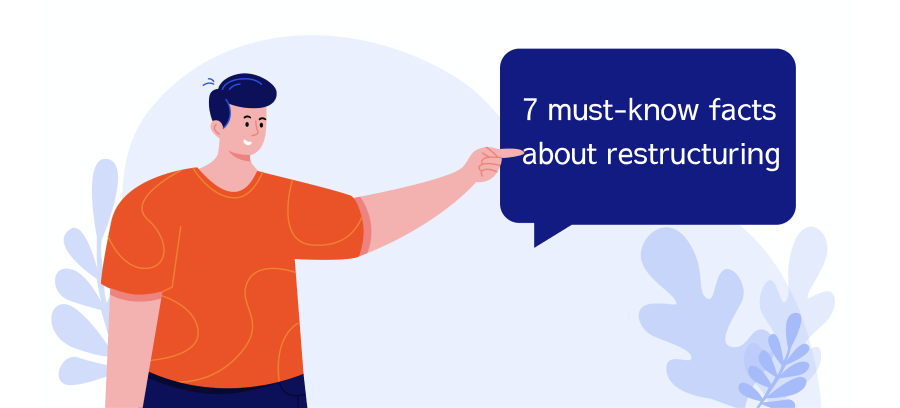
On August 31st, 2020, the RBI mandated moratorium on retail term loans, which was extended from the original 3 months duration to 6 months, came to an end. This sparked much debate on how COVID-19 affected people, who have not had a chance to recover from the effects of the strictest lockdown on Earth, will manage to make payments towards their loans. The Supreme Court, central government and the RBI are still in talks to figure out the best way to proceed, while bearing in mind the hardship of consumers as well as the long term stability and health of banks and other lending institutions.
What we do know is that earlier this month, the Reserve Bank of India (RBI) announced a one-time restructuring scheme for lending institutions to extend to borrowers who are severely affected by COVID-19. So what does that mean for you as a customer?
That’s what we’re unpacking today. Here are 8 must-know facts about loan restructuring and what it means for you:
1. There are eligibility criteria. In order to qualify for this loan restructuring scheme, you would need to prove that you are under severe distress due to the pandemic. Financial institutions have the right and responsibility to request sufficient documentation to satisfy this requirement.
The borrower needs to have been making regular payments towards their loan and the payments towards aforesaid loan were not overdue for more than 30 days as of March 1st, 2020.
2. Loans taken from institutions other than a bank are eligible too. As per the RBI, loans taken from private, public and foreign banks operating in the country, as well as Local Area Banks, small finance banks, regional rural blanks, primary (urban) cooperative banks, district central and state cooperative banks are eligible. Loans taken from NBFCs, all-India financial institutions as well as housing finance companies are also eligible for restructuring.
3. Not all loans are eligible for restructuring but most are. Almost all personal and corporate loans that are under stress as a result of COVID-19 are eligible under the scheme. The exceptions to this are MSME borrowers and lending institutions whose total outstanding loans total less than INR 25 crores or farm credit or loans given to government bodies, as well as loans given to Primary Agricultural Credit Societies and Farmers’ Service Societies that lend to agriculture.
4. The conditions of your loan will change. The restructure can happen in three different ways, and this is left to the discretion of different lenders. The most common way would be to reschedule the payments, generally by extending the tenure of the loan itself. Another way would be to convert the interest that has or will accrue and convert it into a new, small loan. The last way, and most likely to come under scrutiny, would be to grant a moratorium on payments altogether for up to 2 years.
5. You will not be considered in default if you restructure. This is perhaps the greatest benefit granted to customers under the restructuring scheme; should you choose to restructure your loan, your loan will remain a standard loan and not be considered in default until the date agreed upon between you and your lender for the restructuring. Should you choose to not restructure your loan and miss your payments, however, it would be considered under default, which does cause significant damage to your credit score. Many financial experts advise that restructuring and continuing to pay is most beneficial for a borrower.
6. Financial institutions must implement this within 90 or 180 days, depending on the loan. For personal loans, lenders have up to 90 days to implement the restructuring of the actual loan whereas, for corporate borrowers, the restructuring must be implemented within 180 days. Should the lender fail to implement the restructuring within this timeframe, they will miss out on the benefits offered to the institution under the scheme and, most importantly, would have to the loan in question as a non-performing asset (NPA).
7. This is good for lenders too. In exchange for getting payments back in small amounts over a longer period of time, lenders have something to gain. As mentioned above, the loan stays as a standard loan in the institution’s books rather than falling into the default category and being counted as a percentage of the lender’s NPA.
Another benefit is that, while under present rules, lenders have to set aside 15% of the total loan value as a buffer should the loan turn bad, under this scheme for COVID affected loans, lenders can keep aside as low as 10% of the value of the restructured loan in the case of default. For corporate loans, however, this number differs, especially if the lender fails to sign an inter-creditor agreement or ICA within 30 days of the restructuring date in cases where multiple lenders are involved.
This is what we know so far, though a special committee will be called to provide further clarity in regards to this scheme. We hope this has given you some clarification and cleared some of the misinformation regarding this scheme. We would like to echo the opinions of many experts who stress upon borrowers to restructure their loans and continue making payments if possible. This scheme is aimed at providing relief to those who are under severe financial distress and may not be able to cope with their loan payments as originally scheduled.
The information provided is generic and does not speak to the individual policies of all lenders. Please reach out to your own lender/bank should you have any doubts regarding this scheme.



